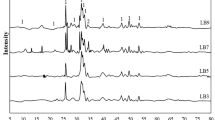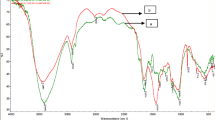Abstract
Hydroxyapatite nanoparticles were synthesized, characterized, and impregnated onto apple pomace surface (HANP@AP) for efficient removal of Pb(II), Cd(II), and Ni(II) ions from water. HANP@AP was characterized by Fourier transform infrared spectroscopy (FTIR), scanning electron microscopy (SEM), energy-dispersive spectroscopy (EDS), transmission electron microscope (TEM), X-ray diffraction (XRD), and surface area analysis. Batch sorption studies were carried out to investigate the influence of different parameters as amount of dose (g), pH, time (min), and initial concentration (mg L−1) on adsorption process. Experimental kinetic data followed pseudo-second-order model and equilibrium data well fitted to Langmuir adsorption model with maximum adsorption capacities of 303, 250, and 100 mg g−1 for Pb(II), Cd(II), and Ni(II) ions, respectively. Competitive adsorption of Pb(II), Cd(II), and Ni(II) ions in presences of each other was studied to evaluate the removal efficiency of HANP@AP against multi metal-loaded water. HANP@AP was successfully applied to real industrial wastewater with 100 % removal of all three metal ions even at high concentration. HANP@AP could be recycled for four, four, and three cycles in case of Pb(II), Cd(II) and Ni(II), respectively. The study showed that HANP@AP is fast, cost effective, and environmental friendly adsorbent for removal of Pb(II), Cd(II), and Ni(II) ions from real industrial wastewater.







Similar content being viewed by others
References
Ali I (2012) New generation adsorbent for water treatment. Chem Rev 112:5073–5091
Al-Qodah Z (2006) Biosorption of heavy metal ions from aqueous solutions by activated sludge. Desalination 196:164–176
Ansari MI, Malik A (2007) Biosorption of nickel and cadmium by metal resistant bacterial isolates from agricultural soil irrigated with industrial wastewater. Bioresour Technol 98:3149–3153
Argun ME, Dursun S, Ozdemir C, Karatas M (2007) Heavy metal adsorption by modified oak sawdust: Thermodynamics and kinetics. J Hazard Mater 141:77–85
Baptista-Neto JA, Smith BJ, McAllister JJ (2000) Heavy metal concentrations in surface sediments in a near shore environment, Jurujuba Sound, Southern Brazil. Environ Poll 109:1–9
Belala Z, Jeguirim M, Belhachemi M (2011) Biosorption of copper from aqueous solution by date stones and palm-trees waste. Environ Chem Lett 9:65–69
Bensacia N, Fechete I, Moulay S, Hulea O, Boos A, Garin F (2014) Kinetic and equilibrium studies of lead(II) adsorption from aqueous media by KIT-6 mesoporous silica functionalized with -COOH. Comptes Rendus Chimie 17(7–8):869–880
Bohli T, Ouederni A, Fiol N, Villaescusa I (2015) Evaluation of an activated carbon from olive stones used as an adsorbent for heavy metal removal from aqueous phases. Comptes Rendus Chimie 18(1):88–99
Cawthray JF, Creagh AL, Haynes CA, Orvig C (2016) Ion exchange in hydroxyapatite with lanthanides. Inorg Chem. doi:10.1021/ic502425e
Chand P, Pakade YB (2013) Removal of Pb(II) from water by adsorption on apple pomace: equilibrium, kinetics, and thermodynamics studies. J Chem 1–8. doi:10.1155/2013/164575
Chand P, Shil AK, Sharma M, Pakade YB (2014) Improved adsorption of Cd2+ ions from aqueous solution using chemically modified apple pomace: mechanism kinetics and thermodynamics study. Inter Biodeter Biodegr 90:8–16
Chouchene A, Jeguirim M, Trouvé G (2014) Biosorption performance, combustion behavior, and leaching characteristics of olive solid waste during the removal of copper and nickel from aqueous solutions. Clean Technol Environmen Pol 16(5):979–986
Crini G (2005) Recent development in polysaccharide-based material used as adsorbent in wastewater treatment. Prog Polym Sci 30:38–70
Cui L, Yaoguang W, Hu L, Gao L, Du B, Wei Q (2015) Mechanism of Pb(II) and methylene blue adsorption onto magnetic carbonate hydroxyapatite/graphene oxide. RSC Adv 5:9759–9770
Elouear Z, Bouzid J, Boujelben N, Feki M, Jamoussi F, Montiel A (2008) Heavy metal removal from aqueous solution by activated phosphate rock. J Hazard Mater 156:412–420
EPA (2011) Edition of the Drinking Water Standards and Health Advisories. http://water.epa.gov/action/advisories/drinking/upload/dwstandards2012.pdf
Feng N, Guo X, Liang S (2009) Adsorption study of copper (II) by chemically modified orange peel. J Hazard Mater 164(2–3):1286–1292
Feng Y, Gong J, Zeng G, Niu Q, Zhang H, Niu C, Deng J, Yan M (2010) Adsorption of Cd(II) and Zn(II) from aqueous solution using magnetite hydroxyapatite nanoparticles as adsorbent. Chemi Eng J 162:487–494
Friberg LI (1985) Rationale of biological monitoring of chemicals—with special reference to metals. Amer Ind Hygie Ass J 46(11):633–642
Ghasemi E, Sillanpää M (2015) Magnetic hydroxyapatite nanoparticles: an efficient adsorbent for the separation and removal of nitrate and nitrite ions from environmental samples. J Sep Sci 38:164–169
Gupta VK, Nayak A (2012) Cadmium removal and recovery from aqueous solutions by novel adsorbents prepared from orange peel and Fe2O3 nanoparticles. Chemi Eng J 180:81–90
Hawari AH, Mulligan CN (2007) Effect of the presence of lead on the biosorption of copper, cadmium and nickel by anaerobic biomass. Process Biochem 42:1546–1552
Ho YS, McKay G (2000) The kinetics of sorption of divalent metal ions onto sphagnum moss peat. Water Res 34:735–742
Homagai PL, Ghimire KN, Inoue K (2010) Adsorption behaviour of toxic metals onto chemically modified sugarcane bagasse. Bioresour Technol 101:2067–2069
Hota G, Kumar BR, Ng WJ, Ramakrishna S (2008) Fabrication and characterization of a boehmite nanoparticle impregnated electrospun fiber membrane for removal of metal ions. J Mater Sci 43:212–217
Jia K, Pan B, Lv L, Zhang Q, Wang X, Pan B, Zhang W (2009) Impregnating titanium phosphate nanoparticles onto a porous cations exchanger for enhanced lead removal from waters. J Coll Interf Sci 331:453–457
Kandah MI, Meunier JL (2007) Removal of nickel ions from water by multi-walled carbon nanotubes. J Hazard Mater 146:283–288
Liu X, Hu Q, Fang Z, Zhang X, Zhang B (2009) Magnetic chitosan nanocomposites: a useful recyclable tool for heavy metal ion removal. Langmuir 25:3–8
Ma Z, Zhao D, Chang Y, Xing S, Wu Y, Gao Y (2013) Synthesis of MnFe2O4@Mn-CO oxide core-shell nanoparticles and their excellent performance for heavy metal removal. Dalton Transact. doi:10.1039/c3dt51310f
Maliyekkal SM, Lisha KP, Pradeep T (2010) A novel cellulose–manganese oxide hybrid material by in situ soft chemical synthesis and its application for the removal of Pb(II) from water. J Hazard Mater 181:986–995
Meena AK, Mishra GK, Rai PK, Rajagopal C, Nagar PN (2005) Removal of heavy metal ions from aqueous solutions using carbon aerogel as an adsorbent. J Hazard Mater 122:161–170
Meski S, Ziani S, Khireddine H (2010) Removal of lead ions by hydroxyapatite prepared from the egg shell. J Chem Eng Data 55:3923–3928
Musico YLF, Santos CM, Dalida MLP (2013) Improved removal of lead(II) from waste using a polymer assisted-based graphene oxide nanocomposites. J Mater Chem A 1:3789–3796
Ngah WSW, Fatinathan S (2008) Adsorption of Cu (II) ions in aqueous solution using chitosan beads, chitosan-GLA beads and chitosan-alginate beads. Chem Eng J 143:62–72
Ngomsik A, Bee A, Siaugue J, Cabuil V, Cote G (2006) Nickel adsorption by magnetic alginate microcapsules containing an extractant. Water Res 40:1854–1856
Nieto-Delgado C, Rangel-Mendez JR (2012) Anchorage of iron hydro (oxide) nanoparticles onto activated carbon to remove As(V) from water. Water Res 46(9):2973–2982
Nuhoglu Y, Malkoc E (2009) Thermodynamic and kinetic study of environmental friendly Ni(II) biosorption using waste pomace of olive oil factory. Bioresour Technol 100:2375–2380
Ozer A, Pirinççi HB (2006) The adsorption of Cd (II) ions on sulphuric acid treated wheat bran. J Hazard Mater 137:849–855
Panneerselvam P, Morad N, Tan KA (2011) Magnetic nanoparticles (Fe3O4) impregnated onto tea waste for removal of nickel (II) from aqueous solution. J Hazard Mater 186:160–168
Pino GH, Souza de Mesquita LM, Torem ML, Pinto GS (2006) Biosorption of cadmium by green coconut shell powder. Miner Eng 19:380–387
Ramesh ST, Rameshbabu N, Gandhimathi R, Nidheesh PV, Kumar MS (2012) Kinetics and equilibrium studies for the removal of heavy metals in both single and binary system using hydroxyapatite. Appl Water Sci 2:187–197
Sharma R, Singh B (2013) Removal of Ni(II) ions from aqueous solution using modified rice straw in fixed bed column. Bioresour Technol 146:519–524
Su Q, Pan B, Pan B, Zhang Q, Zhang W, Lv L, Wang X, Wu J, Zhang Q (2009) Fabrication of polymer-supported nanosized hydrous manganese dioxide (HMO) for enhanced lead removal from waters. Sci Total Environ 407:5471–5477
Tang W, Zeng R, Feng Y, Li X, Zhen W (2013) Removal of Cr(VI) from aqueous solution by nano carbonate hydroxyapatite of different Ca/P molar ratios. Chem Eng J 223:340–346
Tseng Y, Kuo C, Li Y, Huang C (2009) Polymer assisted synthesis of hydroxyapatite nanoparticles. Mater Sci Eng 29:819–822
Wang A, Liu D, Yin H, Wu H, Wada Y, Ren M, Jiang T, Cheng X, Xu Y (2007) Size controlled synthesis of hydroxide nanorods by chemical precipitation in the presence of organic modifiers. Mater Sci Eng C C27:865–869
WHO (2011) Guidelines for Drinking-water Quality fourth edition. http://whqlibdoc.who.int/publications/2011/9789241548151_eng.pdf
Yin M, Li Z, Liu Z, Yang X, Ren J (2012) Magnetic self-assembled zeolite clusters for sensitive detection and rapid removal of mercury (II). ACS Appl Mater Interf 4:431–437
Zhang Q, Pan B, Pan B, Zhang W, Jia K, Zhang Q (2008) Selective sorption of lead, cadmium and zinc ions by a polymeric cation exchanger containing nano-Zr(HPO3S)2. Environ Sci Technol 42:4140–4145
Zhang Q, Du Q, Hua M, Jiao T, Gao F, Pan B (2013) Sorption enhancement of lead Ions from water by surface charged polystyrene-supported nano-zirconium oxide composites. Environ Sci Technol 47:6536–6544
Zhou W, Ge X, Zhu D, Langdon A, Deng L, Hua Y, Zhao J (2011) Metal adsorption by quasi cellulose xanthogenates derived from aquatic and terrestrial plant materials. Bioresour Technol 102:3629–3631
Zhu Y, Stubbs LP, Ho F, Liu R, Ship CP, Maguire JA, Hosmane NS (2010) Magnetic nanocomposites: a new perspective in catalysis. Chem Cat Chem 2:365–374
Acknowledgments
The authors are thankful to the Director, Dr. P. S. Ahuja, CSIR-Institute of Himalayan Bioresource Technology, Palampur, India, for providing required research facilities. Authors are thankful to DST for providing financial support for this work. Mr. Piar Chand thankfully acknowledges the Council of Scientific and Industrial Research (CSIR), India, for providing Senior Research Fellowship (SRF) with acknowledgement number 131338/2 k11/1. Authors also acknowledge Ms. Avnesh Kumari for the help in SEM, FTIR, and EDS analyses.
Conflict of interest
Authors declared that they have no conflict of interest.
Author information
Authors and Affiliations
Corresponding author
Additional information
Responsible editor: Philippe Garrigues
Electronic supplementary material
Below is the link to the electronic supplementary material.
ESM 1
(DOC 174 kb)
Rights and permissions
About this article
Cite this article
Chand, P., Pakade, Y.B. Synthesis and characterization of hydroxyapatite nanoparticles impregnated on apple pomace to enhanced adsorption of Pb(II), Cd(II), and Ni(II) ions from aqueous solution. Environ Sci Pollut Res 22, 10919–10929 (2015). https://doi.org/10.1007/s11356-015-4276-2
Received:
Accepted:
Published:
Issue Date:
DOI: https://doi.org/10.1007/s11356-015-4276-2




